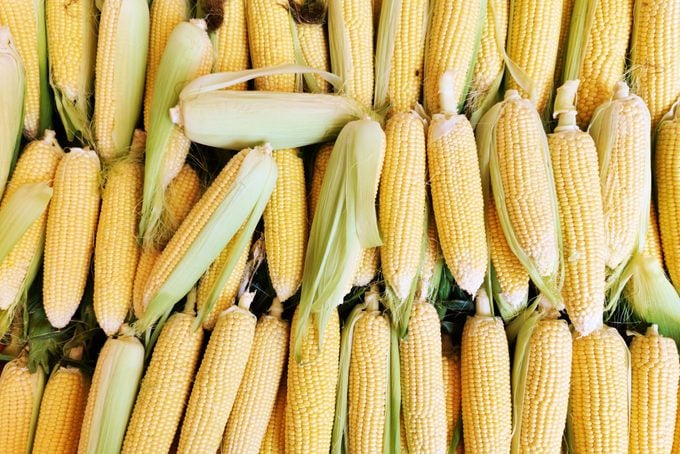10 Items You Might Not Find in Your Grocery Store (and Why)
Updated: Jun. 26, 2023

It looks like food shortages have continued into 2023. This is what might be causing the issue.
After some signs of a return to pre-pandemic normalcy, 2023 is looking remarkably like fall 2020—and that means supply issues at grocery stores. This time the food shortages are scattered throughout the store, so shoppers hoping to get their hands on specific products may find it’s not that easy right now.
“It’s spotty, it’s not a widespread situation,” says Katie Denis, vice president of research for the Consumer Brands Association, which represents the consumer packaged goods industry, including companies like General Mills and Kellogg. “It’s not like at the beginning of the pandemic when people went out and cleared shelves to stockpile and panicked.”
Still, there are specific aisles feeling the strain right now. Here are products to look for during your next grocery run.
What Are Stores Running Short On?
1. Sriracha
According to LA Times, Huy Fong Foods is suffering a chile pepper shortage due to drought in Mexico last summer. While the company hope to prevent a Sriracha shortage like this in the future, there currently is no estimate on when Sriracha will be back in stock.
2. Cooking Oil

The desire to use biofuels instead of fossil fuels may affect your access to some vegetable oils. The Food Institute reports that soybean oil and canola oil, along with other cooking oils, are now being used in the process of biodiesel production. This use of vegetable oil creates a new demand outside of cooking purposes. Producers are already low in stock from bad weather and are trying to keep up with the increase of demand, making a shortage inevitable.
3. Rice
From a mixture of bad weather in rice-producing areas like China and Pakistan, to the ongoing war in Ukraine, the low supply of rice has caused a global shortage, according to CNBC. On the bright side, there is hope that this shortage will come to an end sometime in 2024.
4. Wheat
Ukraine is one of the main suppliers of wheat in the world, and its ongoing invasion by Russia disrupted the supply chain, having a domino affect on bakery goods like bread. Coupled with a ban on exports by India, which was enacted to protect its food security, we’re seeing rising prices when it comes to wheat products along with a possible shortage. Although some states that slashed their grocery taxes may help make groceries more affordable.
5. Corn

Facing the same strain as rice and wheat, corn also has a supply chain shortage caused by the war in Ukraine. The Dairy Reporter says we can expect the price of corn to remain increased while producers try to keep up with the demands of the market.
6. Champagne
According to Wine Enthusiast, demand for champagne dropped in 2020, and then rose again in 2021. This created a problem as the Comité Interprofessionnel du Vin de Champagne (CIVC), the trade organization for the Champagne region, set a lower production cap based on the reduced demand. With the consumer demand in high gear, this shortage is expected to last several years while production tries to get back to a normal schedule.
7. Eggs
The avian flu outbreak in 2022 could have lasting affects on egg supplies for 2023 and years to come, according to Green Matters. Farmers are facing the lost of millions of their birds to this lethal outbreak, reducing the numbers of those able to produce eggs. The costs of the produce continues to rise at grocery stores, putting a strain on those looking for a carton.
8. Beef

According to Washington Times, droughts from 2022 are expected to affect the beef supply for 2023 into 2024. Without enough grass to feed the cattle and the rising costs of feed that farmers wanted to avoid, culling was increased in 2022, leaving less cows for the years to come. It might be time to switch to vegetarian dinners (sans the eggs) for a while to combat this food shortage.
9. Sugar
According to Business Insider, India, a major producer of sugar, has decided to not raise its quota on sugar exports. Other major producers like Brazil, Europe, Mexico, Thailand, China and Pakistan are also facing low supply of the product, causing concerns for a global shortage. If you’re seeing an increase in sugar prices, this could be why.
10. Canned Pet Food
The continuing shortage of aluminum and shipping issues have led to shortages in dog and cat food across the country, with several local papers reporting bare shelves at the pet stores.
Why Are These Items in Short Supply?
It’s because of labor shortages and supply-chain issues, from food manufacturers to grocery stores. There simply aren’t enough people to “make the goods, move the goods and sell the goods,” says Jim Dudlicek, a representative for the National Grocers Association. Labor shortages also continue, with people resigning due to low wages and poor work conditions.
In addition, supply is affected by more people cooking and eating at home, a trend that started at the onset of the pandemic. “Demand has been very, very high,” Denis says. Still, she doesn’t think there’s a reason for people to stockpile. She pointed to lumber as an example of a product that was extremely hard to get for a while, but has become more plentiful in recent months, and the food supply chain likely will rebound in a similar fashion, although it may take time.
How to Shop Responsibly Right Now
If you see purchase limits on products at stores, there’s no reason to panic—or panic buy. The retailers are simply being responsible and managing inventory. “If people can buy what they need, and only what they need, we’ll have enough,” says Denis.
Shoppers should expect that specific items may be harder to get at certain times. Be mindful of your fellow shoppers and only take what you really need. And don’t hesitate to ask your local grocer about item availability.
If you’re hoping to stay out of grocery stores for safety reasons, these stores offer delivery and pickup.




















